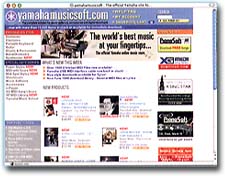|
MIDI is a worldwide
standard computer language that conveys musical
instructions. MIDI stands for Musical Instrument
Digital Interface, and is pronounced "middy." A
keyboard with MIDI can be connected to and
communicate with other MIDI-equipped devices.
Getting Connected
 MIDI
messages travel down a MIDI cable from one MIDI
device (such as a keyboard) to another MIDI
device (such as a personal computer). A MIDI
cable carries information in only one direction,
so a MIDI-equipped keyboard has a MIDI IN and
MIDI OUT port. If you
want your keyboard and your computer to be able
to "talk" to one another, a MIDI cable is used
to connect the MIDI IN and MIDI OUT ports on your keyboard to
the USB (MIDI) port on your
computer. MIDI
messages travel down a MIDI cable from one MIDI
device (such as a keyboard) to another MIDI
device (such as a personal computer). A MIDI
cable carries information in only one direction,
so a MIDI-equipped keyboard has a MIDI IN and
MIDI OUT port. If you
want your keyboard and your computer to be able
to "talk" to one another, a MIDI cable is used
to connect the MIDI IN and MIDI OUT ports on your keyboard to
the USB (MIDI) port on your
computer.

Some keyboards have a USB port which acts as a
MIDI interface. You can connect to your computer
with a USB cable (like the one for a digital
camera) and don't have to purchase a MIDI cable.
What can MIDI do for me?
The important thing about MIDI is not the physical
connectors or the electronics behind it, but what it allows you to do. With MIDI you can:
Connect your keyboard to a personal computer
  Thanks to MIDI, the computer
has emerged as a terrific music-making machine. The
possibilities are endless! Thanks to MIDI, the computer
has emerged as a terrific music-making machine. The
possibilities are endless!
 Plenty of websites on the
Internet are at your disposal for downloading
and purchasing music computer programs, styles and
songs. One of the popular sites is
yamahamusicsoft.com,
a treasure chest of products for Yamaha keyboard
users.
With all of the cool computer stuff available, you can
make some good old-fashioned music in a whole new way --
you'll be wondering how you ever managed before! Plenty of websites on the
Internet are at your disposal for downloading
and purchasing music computer programs, styles and
songs. One of the popular sites is
yamahamusicsoft.com,
a treasure chest of products for Yamaha keyboard
users.
With all of the cool computer stuff available, you can
make some good old-fashioned music in a whole new way --
you'll be wondering how you ever managed before!
Connect to another keyboard
You can add the sounds of another MIDI-equipped keyboard to what you
play on your keyboard.
Connect to other MIDI
instruments
All kinds of electronic instruments such as organs and
drum machines and even acoustic instruments
such as guitar, violin or saxophone can be equipped
with MIDI. You can use your keyboard as a
"controller" and any of these instruments can
be played and controlled right from the keyboard panel.
For example, a church organist would be able to play the
organ from a keyboard in various locations in the church
to better evaluate the acoustics or adjust the speakers
to the pipes.
|
